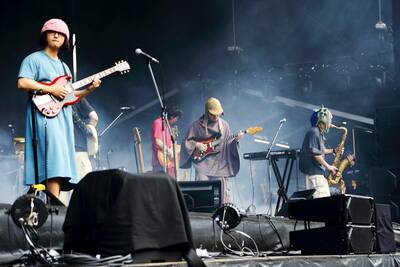In this decorous trifle from France, the young actress Lola Naymark stares into space with moist, empty eyes, tossing her red hair like a pony fretfully swishing away late-summer flies. Naymark's enviable hair, with its springy curls and poetically inflamed color, accounts for much of this film's visual enchantment and also serves as something of an emotional barometer for her teenage character, Claire. The fiery mane either loosely billows, as free as the spirit to which it is attached, or hides from view in a severe turban, but neither humidity nor hats diminish its redoubtable bounce.
Directed by Eleonore Faucher, making her feature debut, the film opens with Claire working behind a cash register and desperately trying to obscure her pregnancy. The teenager has recently moved out of her parents' house, though it is unclear precisely when, and into tastefully arty quarters, where she embroiders bits of cloth with painstaking detail.
The metaphorically minded should not be surprised that Faucher builds her story much as Claire works her embroidery — with studied deliberation and piece by precious piece. Characters are added carefully to the mix, including a mournful young man (Thomas Laroppe) who brings a little heat to Claire's chilly existence, and a grieving mother (Ariane Ascaride) who brings cascades of tears and some bite to an otherwise anodyne setup.

PHOTOS COURTESY OF CINEPLEX
Once Claire can no longer hide her pregnancy, she takes a medical leave. (First, though, she yanks out a fistful of hair in front of her supermarket colleagues, claiming to have cancer.) This gives her time to continue on her poetic drift until, finally, she conveniently floats into the orbit of Madame Melikian (Ascaride), a haute-couture embroiderer whose adult son has recently died in a violent accident. Best known for her work in the films of her husband, Robert Guediguian (Marius and Jeannette, The Town Is Quiet), Ascaride has a no-nonsense, grounded vibe that helps tether the story to the real world. Even when the film grows irritatingly schematic — Madame Melikian and Claire take turns playing parent and child to each other — Ascaride makes you believe that you're watching a character, not a filmmaking conceit.
The French are very good at making movies from wisps of mood and shards of narrative, but even the most diffuse stories need something more: an idea or two, for starters. With Brodeuses (the English title is "Sequins") Faucher displays an exceptional eye for color — she dresses Ms. Naymark in muted greens and blues that offset those red locks beautifully — as well as a nice sense of landscape. She shoots a cabbage patch with the same careful attention with which Claire sews on the adornments of the film's title.
Unfortunately, Faucher's screenplay, written with Gaelle Mace, never finds its focus or reason for being, and Naymark just doesn't have enough screen presence to make up for the lack of a story or to justify all those tenderly attentive close-ups. It's obvious that the director is enamored of her young star, but that isn't a love shared by everyone else.


No one saw it coming. Everyone — including the Chinese Nationalist Party (KMT) — expected at least some of the recall campaigns against 24 of its lawmakers and Hsinchu Mayor Ann Kao (高虹安) to succeed. Underground gamblers reportedly expected between five and eight lawmakers to lose their jobs. All of this analysis made sense, but contained a fatal flaw. The record of the recall campaigns, the collapse of the KMT-led recalls, and polling data all pointed to enthusiastic high turnout in support of the recall campaigns, and that those against the recalls were unenthusiastic and far less likely to vote. That

Behind a car repair business on a nondescript Thai street are the cherished pets of a rising TikTok animal influencer: two lions and a 200-kilogram lion-tiger hybrid called “Big George.” Lion ownership is legal in Thailand, and Tharnuwarht Plengkemratch is an enthusiastic advocate, posting updates on his feline companions to nearly three million followers. “They’re playful and affectionate, just like dogs or cats,” he said from inside their cage complex at his home in the northern city of Chiang Mai. Thailand’s captive lion population has exploded in recent years, with nearly 500 registered in zoos, breeding farms, petting cafes and homes. Experts warn the

A couple of weeks ago the parties aligned with the People’s Republic of China (PRC), the Chinese Nationalist Party (KMT) and the Taiwan People’s Party (TPP), voted in the legislature to eliminate the subsidy that enables Taiwan Power Co (Taipower) to keep up with its burgeoning debt, and instead pay for universal cash handouts worth NT$10,000. The subsidy would have been NT$100 billion, while the cash handout had a budget of NT$235 billion. The bill mandates that the cash payments must be completed by Oct. 31 of this year. The changes were part of the overall NT$545 billion budget approved

Before performing last Friday at Asia’s bellwether music festival, Fuji Rock in Japan, the Taiwanese indie band Sunset Rollercoaster (落日飛車) had previously performed on one of the festival’s smaller stages and also at Coachella, the biggest brand name in US music festivals. But this set on Fuji Rock’s main stage was a true raising of the bar. On a brilliant summer’s evening, with the sun rays streaming down over a backdrop of green mountains and fluffy white clouds, the performance saw the Taiwanese groovemasters team up with South Korean group Hyukoh, with whom they’ve formed a temporary supergroup called AAA